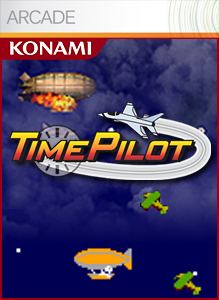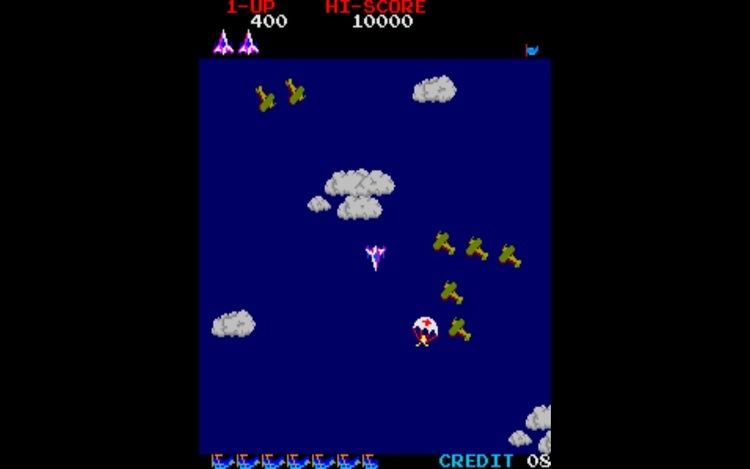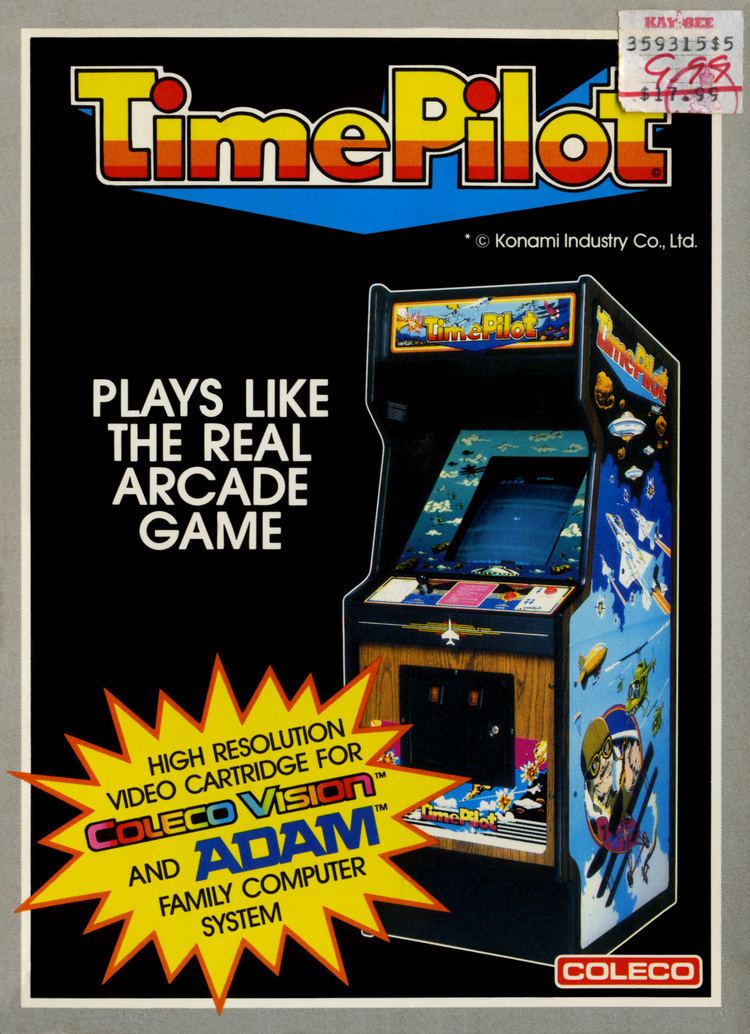6.6 /10 1 Votes
Artist(s) Hideki Ooyama Cabinet Upright | 6.6/10 Arcade Division Composer(s) Masahiro Inoue Initial release date November 1982 Series Oretachi Gēsen Zoku | |||||||||||||||||||||||||||||||||
 | ||||||||||||||||||||||||||||||||||
Genre(s) Multi-directional shooter Mode(s) Up to 2 players, alternating turns Arcade system 2x Zilog Z80, 2x AY-3-8910 Similar Oretachi Gēsen Zoku games, Centuri games, Shoot 'em up games | ||||||||||||||||||||||||||||||||||
Arcade game time pilot 1982 konami
Time Pilot (夕イム・パイ口ツ卜) is a multi-directional scrolling shooter arcade game designed by Yoshiki Okamoto and released by Konami in 1982. It was distributed in the United States by Centuri. It is a time travel themed aerial combat game that allows the player's plane to fly across open air space that scrolls indefinitely in all directions. The Killer List of Videogames included Time Pilot in its list of top 100 arcade games of all time. Home ports for the Atari 2600 and MSX were released in 1983.
Contents
- Arcade game time pilot 1982 konami
- Overview
- Description
- Levels and enemies
- Development
- Re releases
- Clones
- References

A sequel, Time Pilot '84, was released in 1984. It has a top down view instead of a side view, allows the player to shoot guided missiles, and takes place over a science fiction-themed landscape.

Overview

The player assumes the role of a pilot of a futuristic fighter jet, trying to rescue fellow pilots trapped in different time eras. The player must fight off hordes of enemy craft and defeat the mother ship (or "boss") present in every level. The background moves in the opposite direction to the player's plane, rather than the other way around; the player's plane always remains in the center.
Description
This game has the player travel through five time periods, rescuing stranded fellow pilots. The player must fight off droves of enemy craft while picking up parachuting friendly pilots. Once 56 enemy craft are defeated, initially 25 on the MSX platform and increasing by 5 after each game cycle (finishing the last battle against the UFOs), the player must defeat the mothership for the time period. Once she is destroyed, any remaining enemy craft are also eliminated and the player time-travels to the next level. All the levels have a blue sky and clouds as the background except the last level, which has space and asteroids instead. The specific eras visited, the common enemies, and the motherships are the following:
- 1910: biplanes and a blimp
- 1940: WWII monoplanes and a B-25
- 1970: helicopters and a large, blue CH-46
- 1982 (Konami version)/1983 (Centuri version): jets and a B-52
- 2001: UFOs
The mothership is destroyed with seven direct hits. Once all the eras have been visited, the levels start over again but are harder and faster. The Game Boy Advance version of Time Pilot in Konami Arcade Classics includes a hidden sixth era, 1,000,000 BC, where the player must destroy vicious pterodactyls in order to return to the early 20th century.
Levels and enemies
In the first four levels, the common enemies and motherships can fire yellow bullets that are similar to the white bullets fired by the player, except that they travel rather slowly.
In the 1910 level, the biplanes can fire bombs in addition to the yellow bullets. The bombs are initially fired upward but have acceleration in the downward direction, meaning that they will move faster as they fall to the bottom of the screen. This seems to be the work of gravity since the bombs follow the parabolic trajectory of a thrown object, despite the fact that the downward direction of the screen does not seem to point toward the "ground"—the player can fly downward indefinitely and not reach the "ground". This is the only time when "gravity" is present. However, the acceleration imparted on the bombs makes them quite potent as they pick up speed.
The 1940 planes lack the tin-can-resembling bombs of the 1910 biplanes. They are slimmer than the biplanes, though, and blend in with the background, making them tougher to target. In addition, in this level there will sometimes be red-and-yellow supply planes that fly horizontally across the screen. They require multiple hits to take down (much like the mothership) and reward the player 1500 points upon their destruction. They cannot fire at the player, and pose no real threat so long as the player does not crash into them.
The helicopters of 1970 are even smaller than the monoplanes. In addition to the common yellow bullets, they can also fire homing missiles. The missiles travel slightly faster than the player, but cannot make sharp turns. The player can destroy missiles by shooting them, but can also avoid them by turning sharply.
The jets in 1982 are larger, better versions of the helicopters. They are larger and more aggressive, making it easier for the player to run into them. Their preference of homing missiles over the standard yellow bullets is more pronounced than that of the helicopters, meaning that there will typically be more missiles trailing the player in 1982 than in 1970.
In 2001, the UFOs fire fast-travelling circular bullets that blend in with the background. The asteroids on screen will not hurt the player but will serve to camouflage the enemies and their missiles.
All levels have parachutes that can be collected, starting at 1000 points and increasing by 1000 points for each consecutive parachute collected, up to a maximum of 5000 points per parachute. Loss of a life resets the parachute value back to 1000 points.
All levels have formations of the enemies, that appear shortly after quick series of tones play, and those award 2000 points if the entire formation is destroyed within approximately 3 seconds.
Development
According to his account, Yoshiki Okamoto's proposal for Time Pilot was initially rejected by his boss at Konami, who assigned Okamoto to work on a driving game instead. Okamoto secretly gave instructions to his programmer to work on his idea, while pretending to be working on a driving game in front of his boss. When Time Pilot was a success, Okamoto's boss claimed credit for Okamoto's idea. The free-roaming style of gameplay used in Time Pilot was influenced by Namco's Bosconian.
Re-releases
Clones
Fury is a 1983 clone from Computer Shack for the TRS-80 Color Computer.
Two clones with almost identical names were released in 1984: Kingsoft's Space-Pilot for the Commodore 64 and Superior Software's Space Pilot for the BBC Micro.
